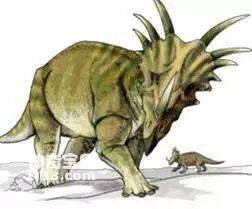Styracosaurus is also a large horned dragon. The significant difference between it and other ceratopsians is the neck shield. There is a circle of sword-like bone spines on the edge of the neck shield of Styracosaurus, which looks like a row of "painted halberds" inserted behind the back of ancient warriors. It is extremely powerful. In addition, the head and body features of Styracosaurus are very similar to those of Styracosaurus. The horn above the nose of Styracosaurus was very long, and it was slightly convex above the eyes.
Styracosaurus has strong defensive and offensive capabilities. The spiked neck shield not only blocks and protects oneself, but also reduces the weight of the head and makes head movement more flexible. The bone spurs on the horns and neck shield are like sharp swords. They are terrifying weapons that can be used for defense and offense, enough to make any ferocious predator tremble with fear. When fighting a carnivorous dinosaur, Styracosaurus only had to lift its head from bottom to top, and several "sharp swords" would immediately pierce the chest of the oncoming aggressor.
Even though they are far apart, opponents will never mistake Styracosaurus. Like the huge horns of the female red deer, the peculiar spikes on the neck shield could attract the opposite sex and deter the Styracosaurus' natural enemies. Styracosaurus never enters into a fight easily, usually just shaking its head - a slight intimidation gimmick!
For fighting purposes, the sharp horns on Styracosaurus' head are too insignificant, but it has another weapon that scares its opponents - its huge nose horn! Styracosaurus suddenly attacks with its nose horn, often dealing a devastating blow to large carnivores. Its nose horn can pierce the exposed flesh of carnivorous dinosaurs and leave a round hole-shaped wound there.
The cervical vertebrae of Styracosaurus were very strong and could help support its huge head. The Styracosaurus, which was longer than two cars, walked on strong limbs, with its toes pointed outward to stand firm and easily support the weight of the body.
Styracosaurus once roamed the Great Plains of North America, using its curved beak like a parrot to cut and eat the branches and leaves of low-crown plants. Overall, there is not much difference between Styracosaurus and Triceratops, except that they are slightly smaller. The neck shield is wrinkled, and there are long spikes on the upper edge, as if many more horns have been added. There are also spikes on the sides, but they are much shorter. With these weapons, it can protect itself very well. When attacking other dinosaurs, the horns of its nose could pierce the enemy's body, while the neck shield could protect its neck from attacks by sharp teeth and claws.
From the dinosaur footprints discovered in Texas, USA, we can see some scenes of dinosaur families marching: small young dinosaurs walking in the middle of the team, while large adult dinosaurs are on both sides. Sometimes the adult dinosaur is in front, with the young following behind. Many of the ceratopsian species mentioned above lived a loving family life. The Styracosaurus discovered in Canada proves: A Styracosaurus family was traveling for food. Suddenly, a carnivorous dinosaur named Albertosaurus rushed out of the nearby forest. It wanted to kill a small Styracosaurus as a meal, so the family The members immediately formed a circle and pointed their horns like weapons at the incoming enemy. As the Chinese say when describing the power of family ties: "Brothers fight, father and son go into battle." It is difficult to offend with public anger, so Albertolong had no choice but to be defeated and leave quietly. It was this power of family affection that allowed ceratopsians to multiply at the end of the Cretaceous, once again demonstrating the powerful vitality of dinosaurs. It is conceivable that although ceratopsians were the last members of the dinosaur family that experienced the extinction of the dinosaurs, they also disappeared from the earth while caring for and rescuing each other, and being reluctant to leave when they encountered extinction. .

Chinese name: Styracosaurus
Latin name: Styracosaurus
Age of survival: Late Cretaceous
Fossil origin: Montana, USA, Canada
Physical characteristics: 5~6 meters long
Diet: plants
Species: Ceratopsian
Definition: lizard with spear
animal tags: Styracosaurus
We created this article in conjunction with AI technology, then made sure it was fact-checked and edited by a Animals Top editor.